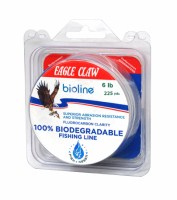 DENVER, Colo. - Rod and reel anglers of all kinds are connected by a common thread, literally, in that they rely on fishing line as their link between man and fish. Nylon monofilament, ever since first coming on the fishing scene in the mid-1930s, has grown to become the predominant line type of choice because of its affordability, strength and durability.
DENVER, Colo. - Rod and reel anglers of all kinds are connected by a common thread, literally, in that they rely on fishing line as their link between man and fish. Nylon monofilament, ever since first coming on the fishing scene in the mid-1930s, has grown to become the predominant line type of choice because of its affordability, strength and durability.In fact, monofilament line is so durable that scientists say it can remain in the environment for as long as 600 years. With that said, there’s probably not a fisherman out there who hasn’t lost a fish or a favorite lure because of having become entangled in old fishing line snags underwater. The reality is that our country’s 40 million-plus anglers, who spend an average X days per year fishing, use a lot of fishing line.
Fortunately, leaders in the recreational fishing industry have always been the ones to keep the environment and tomorrow’s anglers in mind, and that is exactly why Eagle Claw® Fishing Tackle Co. proudly offers bioline®, a true 100 percent biodegradable premium fishing line that was born from the medical industry. Bioline is engineered to retain its strength and durability for 10-12 months of use, and then completely degrade in water or on land within five years.
“Bioline has all of the performance properties of monofilament – outstanding abrasion and knot strength, and the clarity of fluorocarbon – but is highly more environment friendly,” said Chris Russell, marketing director at Wright & McGill Co. “Fishermen themselves have always been this sport’s greatest advocates for doing the right thing to pass forward the legacy of fishing, and fishermen really ‘get it’ as to why biodegradable fishing line is a big deal.”
Bioline is made from a special formula of biodegradable polymers, resulting in the earth-friendly alternative to nylon because it does breakdown so much faster to become a simple combination of carbon dioxide (CO2), water (H2O) and biomass. The degradation process starts at the surface of the line, with microorganisms breaking down and digesting bioline with the aid of sunlight and moisture.
Bioline begins to lose its tensile strength in 10-12 months of use. As its tensile strength deteriorates, it becomes much less a nuisance to all who enjoy the aquatic environment, including wildlife and anglers.
Of all anglers, crappie fishermen in particular especially benefit from biodegradable fishing line because they spend the majority of their pursuit of the species in and around cover, especially submerged wood. Hardwood brushpiles can provide good crappie habitat for years and years, but the most popular ones can end up a mess through an accumulation of snagged and broken-off lines over time.
“Without a doubt, old fishing line in the water is our number one nuisance in how a lot of us fish for the big slabs here in Mississippi,” said crappie guide Bo Hudson of Jackson. “When we’re long-line trolling over or near brush with several lines out, it can get ugly in a hurry upon encountering snagged lines down there. Who wouldn’t want biodegradable fishing lines to become the standard for our sport?”
Mike Taylor, a fishing guide from Okmulgee, Okla., shared similar thoughts. “I have favorite brushpiles I have to avoid with my novice-angling clients because they get hung up so bad on all the previous break-offs down there,” he said. “It’s a lot easier to get a lure, hook or fish free from a branch or stump that it is snarled fishing line. I love the thought of my brushpiles being self- cleaning through use of bioline.”
Another reason bioline is a natural for crappie anglers is because of available line sizes and filler spool capacities. Bioline comes in 4, 6, 8, 10 and 12 lb. test, and each size is sold on a spool containing 225 yards. As a general rule, crappie reels are small and hold less than 100 yards of line, meaning a spool of bioline is good for two or three fill-ups. Bioline retails for around $11.99 per spool.
Bioline packaging is engineered to be air and water tight for use in storing the unused portion in between refills. It is recommended the package be kept in a cool and dry place.
“Today’s reels perform best with fresh line and their spools filled to the maximum level, so anglers in-the-know are already changing their line on a frequent basis throughout the season,” said Russell. “Since we guarantee bioline to retain 100 percent of its strength for the average use of 10 months, this Eagle Claw product is the perfect answer for anglers interested in doing their part for the environment. Bioline is a first-class line and worthy of consideration for any angler and all kinds of fishing.”
Eagle Claw got its start in the late 1920s and has always been a leader in innovative, environmentally friendly products that serve the present needs of current anglers while also preserving the planet for future generations to enjoy. In addition to bioline, other “Fish Green®” products in the Eagle Claw lineup include non-lead weights and sinkers, circle hooks, barbless hooks and degradable packaging.
For more information about Eagle Claw bioline, visit www.biolineFishing.com. For more information about Eagle Claw, visit www.EagleClaw.com.




 Articles and Stories
Articles and Stories
















